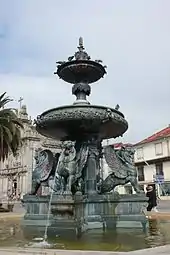| Fountain of the Lions | |
|---|---|
| Fonte dos Leões | |
.jpg.webp) A view of the fountain in the Praça de Parada Leitão | |
| Artist | Compagnie Générale des Eaux pour l'Etranger |
| Medium | Marble |
| Location | Porto, Portugal |
| 41°8′50″N 8°36′56″W / 41.14722°N 8.61556°W | |
| Owner | Câmara Municipal de Sintra |
The Fountain of the Lions (Portuguese: Fonte dos Leões), is a 19th-century fountain built by French company Compagnie Générale des Eaux pour l'Etranger, in the civil parish of Cedofeita, Santo Ildefonso, Sé, Miragaia, São Nicolau e Vitória in municipality of Porto. Cast by the Val d’Osne foundry in France, it is a copy, in most part, of the fountain in the Town Hall Square of Leicester, England
History

.jpg.webp)
A competition was held in 1880, by the municipal water authority of Porto, under the direction of António Pinto de Magalhães (then president of Câmara Municipal of Porto).[1] This resulted in an 1882 contract with the only submeter, the Compagnie Générale des Eaux pour l'Etranger.[1] A decree was issued on 17 July 1882, which elaborated the and approved the provisional contract, which was promulgated on 27 July.[1]
Work was initiated in 1883, to begin the supply of water to the city.[1] This new project included a supply that included the design for the Lion fountain.[1] On 30 August 1883, the design was rejected by the municipal commission, but on 13 August 1885, the municipal representatives approved the project sent by Carlos de Pezerat (4 July).[1] Construction began on 25 September, and water began to flow as on 19 December 1886.[1]
By 1 January 1887, the public water supply project for the city of Porto was concluded.[1]
From 1942, the fountain was a less obligatory passage channels of the city, and began to be supplied by the Arca de Sá Noronha.[1]
Architecture
The fountain is located in an urban, isolated location, within the gardened Praça de Gomes Teixeira.[1]
The central fountain has a cruciform layout with a group of sculptures at the base supported by four seated lions on the extremes.[1] Between each lion, the axis of the source has a column with base, shaft and capital.[1] To top, two central, circular cups superimposed and staggered, with a pine cone surmounting all.[1] The octagonal shaped granite tank has rounded edges. The outer profile of the tank walls is corrugated.[1] The edge of the lower plane bowl is outlined in relief by a frieze with plant elements interrupted only by four cornets from which water flows.[1]
References
Notes
Sources
- O Comércio do Porto (in Portuguese), 21 December 1886
- Marçal, Horácio, "O abastecimento de água à cidade do Porto e á vila de Matosinhos", O Tripeiro (in Portuguese) (Série VI, Ano VIII ed.), p. 344